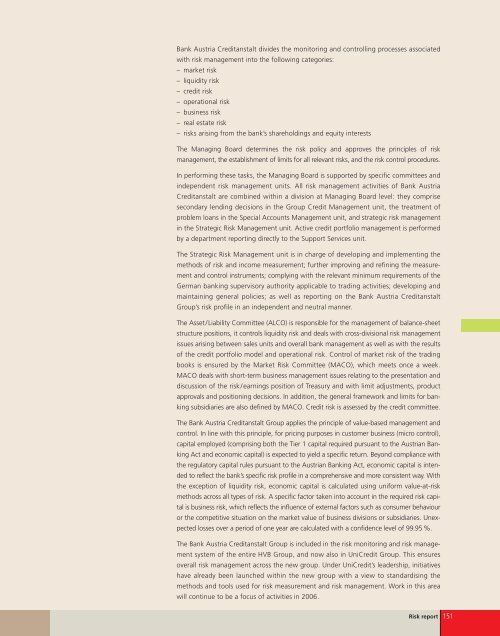team spirit - Bankier.pl
team spirit - Bankier.pl
team spirit - Bankier.pl
Create successful ePaper yourself
Turn your PDF publications into a flip-book with our unique Google optimized e-Paper software.
Bank Austria Creditanstalt divides the monitoring and controlling processes associated<br />
with risk management into the following categories:<br />
– market risk<br />
– liquidity risk<br />
– credit risk<br />
– operational risk<br />
– business risk<br />
– real estate risk<br />
– risks arising from the bank’s shareholdings and equity interests<br />
The Managing Board determines the risk policy and approves the princi<strong>pl</strong>es of risk<br />
management, the establishment of limits for all relevant risks, and the risk control procedures.<br />
In performing these tasks, the Managing Board is supported by specific committees and<br />
independent risk management units. All risk management activities of Bank Austria<br />
Creditanstalt are combined within a division at Managing Board level: they comprise<br />
secondary lending decisions in the Group Credit Management unit, the treatment of<br />
problem loans in the Special Accounts Management unit, and strategic risk management<br />
in the Strategic Risk Management unit. Active credit portfolio management is performed<br />
by a department reporting directly to the Support Services unit.<br />
The Strategic Risk Management unit is in charge of developing and im<strong>pl</strong>ementing the<br />
methods of risk and income measurement; further improving and refining the measurement<br />
and control instruments; com<strong>pl</strong>ying with the relevant minimum requirements of the<br />
German banking supervisory authority ap<strong>pl</strong>icable to trading activities; developing and<br />
maintaining general policies; as well as reporting on the Bank Austria Creditanstalt<br />
Group’s risk profile in an independent and neutral manner.<br />
The Asset/Liability Committee (ALCO) is responsible for the management of balance-sheet<br />
structure positions, it controls liquidity risk and deals with cross-divisional risk management<br />
issues arising between sales units and overall bank management as well as with the results<br />
of the credit portfolio model and operational risk. Control of market risk of the trading<br />
books is ensured by the Market Risk Committee (MACO), which meets once a week.<br />
MACO deals with short-term business management issues relating to the presentation and<br />
discussion of the risk/earnings position of Treasury and with limit adjustments, product<br />
approvals and positioning decisions. In addition, the general framework and limits for banking<br />
subsidiaries are also defined by MACO. Credit risk is assessed by the credit committee.<br />
The Bank Austria Creditanstalt Group ap<strong>pl</strong>ies the princi<strong>pl</strong>e of value-based management and<br />
control. In line with this princi<strong>pl</strong>e, for pricing purposes in customer business (micro control),<br />
capital em<strong>pl</strong>oyed (comprising both the Tier 1 capital required pursuant to the Austrian Banking<br />
Act and economic capital) is expected to yield a specific return. Beyond com<strong>pl</strong>iance with<br />
the regulatory capital rules pursuant to the Austrian Banking Act, economic capital is intended<br />
to reflect the bank’s specific risk profile in a comprehensive and more consistent way. With<br />
the exception of liquidity risk, economic capital is calculated using uniform value-at-risk<br />
methods across all types of risk. A specific factor taken into account in the required risk capital<br />
is business risk, which reflects the influence of external factors such as consumer behaviour<br />
or the competitive situation on the market value of business divisions or subsidiaries. Unexpected<br />
losses over a period of one year are calculated with a confidence level of 99.95 %.<br />
The Bank Austria Creditanstalt Group is included in the risk monitoring and risk management<br />
system of the entire HVB Group, and now also in UniCredit Group. This ensures<br />
overall risk management across the new group. Under UniCredit’s leadership, initiatives<br />
have already been launched within the new group with a view to standardising the<br />
methods and tools used for risk measurement and risk management. Work in this area<br />
will continue to be a focus of activities in 2006.<br />
Risk report 151
















